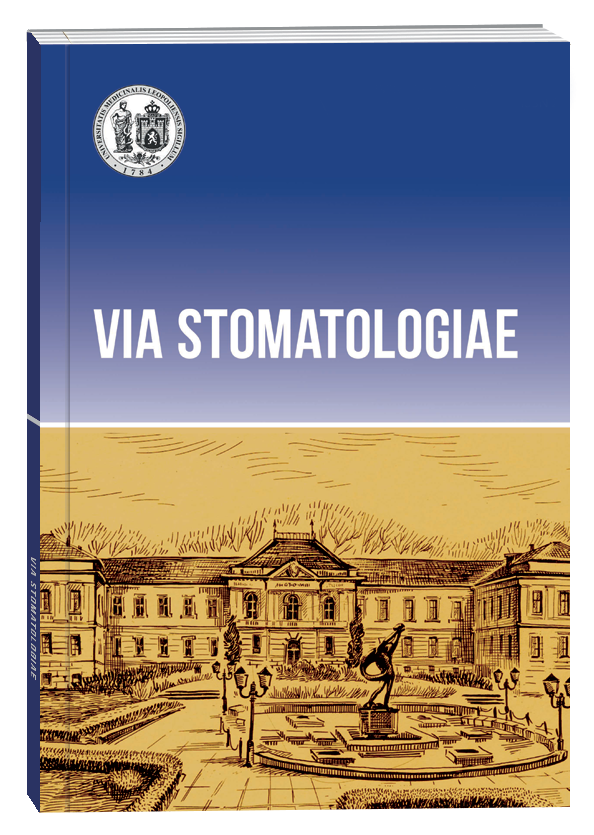FEATURES OF THE CLINICAL COURSE AND REHABILITATION OF PERIODONTAL DISEASES IN PATIENTS WITH FUNCTIONAL OCCLUSION DISORDERS
DOI:
https://doi.org/10.32782/3041-1394.2024-3.9Keywords:
periodontal disease, occlusal diagnosis, traumatic occlusionAbstract
Introduction. The aim of the study is to review literary and scientific sources of information regarding the impact of functional occlusion disorders on the development, course, and treatment of periodontal diseases. Research materials and methods. The methodology of this study was based on the search and analysis of scientific results regarding the outlined problematic issues of the impact of occlusal disorders on the functional state of the maxillofacial system, which is a risk factor for the occurrence of focal dystrophic processes in periodontal diseases, and also significantly worsens the prognosis of treatment. Results. Scientific data on the impact of occlusal disorders on the state of the maxillofacial system, the functional load of the periodontium, and the development and progression of periodontal diseases have been analyzed. Conclusions: 1. It was established that the multi-vector nature of the pathogenetic mechanisms of periodontal tissue damage allows to significantly expand the understanding of the impact of occlusal disorders on the periodontal status and indicates the need for further competent research. 2. One of the important objective methods of detecting premature contact of teeth and interferences is the diagnosis of functional occlusion in an articulator adjusted for individual function. 3. It is necessary to take into account such components of occlusal balance as contact force, contact time, percentage of contacts, resulting occlusal forces, total load vector. 4. In order to achieve long-term successful results in the treatment of periodontal diseases, a comprehensive approach to treatment and preventive measures is necessary, taking into account all the pathogenetic links of their development, therefore the restoration of functional occlusion and supportive therapy are essential to achieve stabilization of the state of periodontal tissues.
References
Захворювання пародонту та аномалії і деформації зубощелепної системи у хворих різного віку (стан проблеми та шляхи її вирішення). Праці НТШ / О. Годований та ін. Медичні науки. 2019. № 1. С. 10–30. DOI: 10.25040/ntsh2019.01.02.
Impact of the global burden of periodontal diseases on health, nutrition and wellbeing of mankind: a call for global action / M.S. Tonetti et al. J Clin Periodontol. 2017. № 44. P. 456–462. DOI: 10.1111/jcpe.12732.
Щільність мікробної колонізації порожнини рота осіб молодого віку залежно від інтенсивності карієсу / Т.А. Петрушанко та ін. Світ медицини та біології. 2013. № 4 (41). С. 49–52.
Запальні захворювання пародонта / Т.Д. Заболотний та ін. Львів : ГалДент, 2013. 206 с.
Авдєєв О.В. Структурні зміни тканин пародонта в експерименті. Вісник стоматології. 2010. № 2. С. 2. URL: http://nbuv.gov.ua/UJRN/VSL_2010_2_3.
Діагностика травматичної оклюзії та планування ортопедичних заходів при генералізованому пародонтиті / В.П. Неспрядько та ін. Сучасна стоматологія. 2018. № 5. Ст. 62–67.
Passanezi Euloir, Passanezi Sant’Ana Adriana Campos. Role of occlusion in periodontal disease. Periodontol. 2000. 2019 Feb. № 79 (1). P. 129–150. DOI: 10.1111/prd.12251.
A new classification scheme for periodontal and peri-implant diseases and conditions – Introduction and key changes from the 1999 classification / J.G. Caton et al. J Clin Periodontol. 2018 Jun. 45 Suppl 20. S1–S8. DOI: 10.1111/jcpe.12935.
Periodontal diseases / D.F. Kinane et al. Nat Rev Dis Primers. 2017 Jun 22. № 3. P. 17038. DOI: 10.1038/nrdp.2017.38.
Риберт Ю.О. Аналіз ефективності лікування пацієнтів із суглобовими скронево-нижньощелепними розладами. Клiнiчна стоматологія. 2016. № 3.
Вибіркове пришліфовування зубів як підготовчий етап ортопедичного лікування пацієнтів із захворюваннями скронево-нижньощелепнтго суглоба / В.П. Гавалешко та ін. World Science. July 2018. № 7 (35). Vol. 4. https://doi.org/10.31435/rsglobal_ws/12072018/6027.
The intricate anatomy of the periodontal ligament and its development : Lessons for periodontal regeneration / T. de Jong et al. J Periodontal Res. 2017 Dec. № 52 (6). P. 965–974. DOI: 10.1111/jre.12477.
Staging and grading of periodontitis: Framework and proposal of a new classification and case definition / Maurizio S. Tonetti et al. J Periodontol. 2018 Jun. 89 Suppl 1. S159–S172. DOI: 10.1002/JPER.18-0006.
Risk factor assessment tools for the prevention of periodontitis progression a systematic review / N.P. Lang et al. J Clin Periodontol. 2015 Apr. 42 Suppl 16. S59–70. DOI: 10.1111/jcpe.12350.
Contemporary relevance of occlusion and mastication / Iven Klineberg et al. Int J Prosthodont. 2014 Sep – Oct. № 27 (5). P. 411–2. DOI: 10.11607/ijp.2014.5.e.
Dawson R.P. Functional Occlusion: from TMJ to smile design. St. Louis : Mosby, 2007. P. 379–382.
Fan J., Caton J.G. Occlusal trauma and excessive occlusal forces: Narrative review, case definitions, and diagnostic considerations. Journal of Periodontology. 2018. № 89. S214 – S222. DOI: 10.1002/jper.16-0581.
Slavichek R. Relationship between occlusion and temporomandibular disorders: implications for the gnatologist. Am. Orthod Dentofacial Orthop. 2011. № 1 (139). Р. 10–14.
Smukler Hyman. Equilibration occlusale et denture naturelle: Logique et technique. CDP EDITIONS. 1998.
Periodontitis – infection or inflammation? / M.L. Laine et al. Ned Tijdschr Tandheelkd. 2021 Dec. № 128 (12). P. 599–603. DOI: 10.5177/ntvt.2021.12.21109.
Understanding the microbial components of periodontal diseases and periodontal treatmentinduced microbiological shifts / Ioannis Fragkioudakis et al. J Med Microbiol. 2021 Jan. № 70 (1). DOI: 10.1099/jmm.0.001247.
In vitro cellular aging stimulates inlerleukin 1 beta production in stretched human periodontal ligament derived cells / N. Shemizu et al. J. Dent. Res. 1997. № 76 (6). P. 1367–1375.
Association between signs of trauma from occlusion and periodontitis / B.L. Pikhstrom et al. J Periodontol. 1986. № 57 (1). P. 1–6.
Occlusal Rehabilitation : A Review / Dr. Siddhartha Bhowmick et al. Saudi Journal of Oral and Dental Research. Dubai, United Arab Emirates : Scholars Middle East Publishers. DOI: 10.21276/sjodr.2019.4.8.3.
Occlusion, orthodontic treatment, and temporomandibular disorders : a review / J.A. McNamara Jr. et al. J Orofac Pain. 1995 Winter. № 9 (1). P. 73–90.
Comparative Study Qualitative and Quantitative Techniques in the Study / Tanya Bozhkova et al. Occlusion Biomed Res Int. 2021 Sep 23. 1163874. DOI: 10.1155/2021/1163874.
Effectiveness of occlusal splint therapy in the management of temporomandibular disorders: network meta-analysis of randomized controlled trials / E.A. Al-Moraissi et al. J. Oral Maxillofac. Surg. 2020. № 49 (8). DOI: 10.1016/j.ijom.2020.01.004.
Occlusal stabilization splint for patients with temporomandibular disorders: Meta-analysis of short and long term effects / P.J. Kuzmanovic et al. PLoS One. 2017. № 12 (2). P. 1–21.
Antimicrobial therapy in periodontitis: the use of systemic antimicrobials against the subgingival biofilm / D. Herrera et al. J Clin Periodontol. 2008. № 35 (Suppl). P. 45–66.
Current Concepts in the Management of Periodontitis / Tae Hyun Kwon et al. Int Dent J.2021 Dec. № 71 (6). P. 462–476. DOI: 10.1111/idj.12630.







